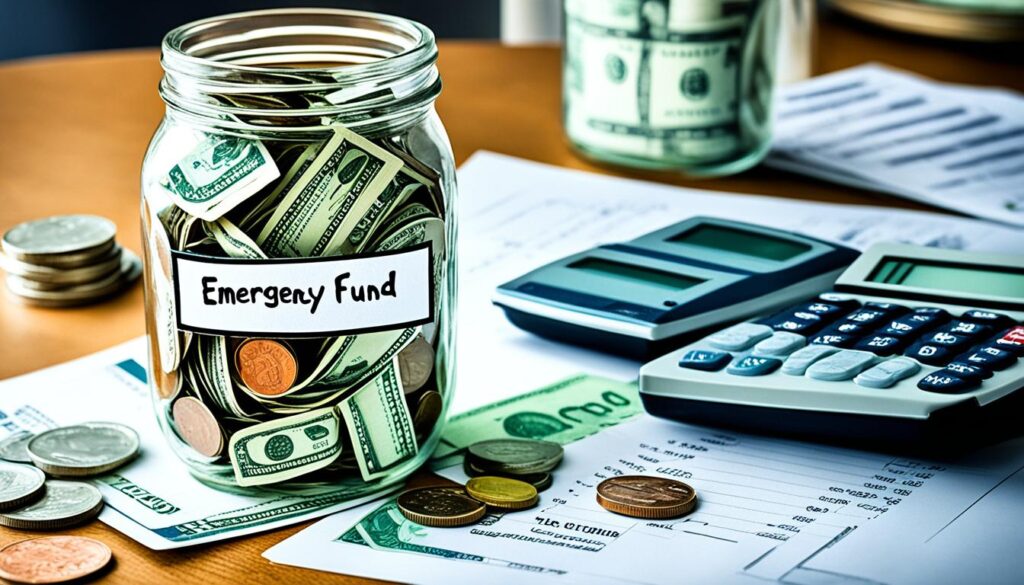Did you know that around 60% of Americans lack even a modest emergency fund, which is typically advised to cover at least three months’ worth of take-home pay1? In a world where financial uncertainty is the norm, the critical dilemma faced by many graduates and young professionals is the choice between focusing on student loan repayment and building emergency savings. With student loan payments resuming post-pandemic, individuals are urged to rethink their financial priorities. Establishing a balance between debt and savings is essential for achieving long-term financial stability. Setting aside even modest amounts early on can significantly benefit future savings through the power of compounding interest, while timely loan payments help to build credit history and may qualify borrowers for tax deductions. Furthermore, contributing to employer-sponsored retirement plans can provide valuable matches, effectively functioning as free money for the future.
Key Takeaways
- Emergency savings are vital for financial stability, especially in times of uncertainty.
- Prioritizing obligations like high-interest debt can lead to better money management.
- A balanced approach to repayment and saving could maximize financial growth.
- Understanding options for student loan repayment can alleviate long-term financial stress.
- Saving modest amounts early can compound into significant savings over time.
The Importance of Financial Planning in Today’s Economy
Effective financial planning is essential in today’s volatile economy. Individuals face uncertainties that make understanding personal finance crucial for long-term financial stability. Keeping a close eye on income, expenses, and cash flow management can lead to informed decisions that safeguard against debt.
Understanding Personal Finance
Grasping the fundamentals of personal finance helps individuals navigate through economic challenges. Many financial advisors recommend maintaining at least three months’ worth of expenses in savings as a buffer for emergencies, ensuring that individuals feel secure during unexpected financial challenges2. Alarmingly, 43% of U.S. adults with credit card debt cite emergency or unexpected expenses as a significant contributor to their monthly debt load3. Such statistics underscore the necessity for a solid understanding of personal finance principles.
The Role of Budgeting in Financial Stability
Budgeting plays a vital role in achieving financial stability. Creating a comprehensive budget allows individuals to allocate funds properly, striking a balance between saving and debt repayment. It has been reported that only 44% of Americans could confidently cover an unexpected $1,000 expense from their savings3. The discomfort associated with insufficient emergency savings is common, with 59% of people expressing reservations about their saved amount3. Experts suggest directing 20% of each paycheck towards an emergency fund to effectively safeguard against future uncertainties4.

Emergency Savings: Why They Matter
Establishing emergency savings is vital for financial security, helping to mitigate unexpected expenses that can arise at any time. These savings create a safety net, protecting you from debt accumulation during crises. Experts recommend having an emergency fund that can cover three to six months’ worth of living expenses, ensuring you have sufficient resources during unforeseen circumstances like job loss or medical emergencies56.
Building a Safety Net for Unexpected Expenses
Many individuals face challenges when it comes to saving for emergencies. Statistics reveal that approximately 30% of adults are unable to cover three months of expenses by any means, underscoring the necessity for a dedicated emergency savings plan7. Starting small, such as saving an amount that can cover essential bills, around $500, can set a solid foundation. Gradually increasing savings to reach half a year’s worth of expenses can protect you from relying on loans or credit cards during financial hardships.
Recommended Savings Amounts and Strategies
To build a robust emergency fund, it is advisable to differentiate between emergency savings and regular accounts. High-yield savings accounts can provide competitive annual percentage yields (APYs), often around 5.05% to 5.50%, enhancing your savings potential5. Additionally, money market accounts typically offer APYs of about 4.00%, with no minimum balance required5. Incorporating strategies like setting monthly savings goals, automating transfers, and regularly reviewing your contributions can significantly aid in growing your emergency fund.

| Type of Account | Typical APY | Minimum Balance | Notes |
|---|---|---|---|
| High-Yield Savings Account | 5.05% – 5.50% | Varies | Best for building emergency savings |
| Money Market Account | ~4.00% | None | Offers liquidity and competitive interest |
| Traditional Savings Account | 0.01% – 0.05% | Often has a low requirement | Lower interest, but accessible |
By establishing a dedicated emergency savings account, you not only secure your financial future but also cultivate a habit that reinforces overall financial stability.
Student Loan Repayment Options and Strategies
Navigating the complexities of student loan repayment requires an understanding of the various loan options available. Each option carries its own terms, making it crucial for borrowers to choose wisely based on their financial situation. Income-driven repayment plans offer flexibility, adjusting payments based on income levels. This can be particularly helpful for graduates who may struggle to make payments right after leaving school. Additionally, some programs offer student loan forgiveness after a set period of qualifying payments, influencing how individuals prioritize repayment.
Understanding Your Loan Options
Taking time to explore the different types of student loans is imperative. Federal loans often provide benefits like lower interest rates and more favorable repayment terms compared to private loans. Understanding these differences assists borrowers in managing their obligations effectively. Many graduates are often left weighing various loan options, making decisions on whether to focus on repayment or set aside savings can be crucial for future financial health. A common recommendation is allocating 20% of monthly income for savings, with 50% directed toward essential expenses and 30% toward discretionary spending8. This budgeting strategy allows for a balanced financial approach while ensuring that borrowers do not overlook their loan responsibilities.
Debt Management Strategies for Students
Implementing effective debt management strategies is key to successfully navigating student loan repayment. Prioritizing high-interest debts can significantly reduce the total amount paid over time, freeing up funds for other financial goals. Consumers can benefit from options like debt consolidation, which simplifies payments and can lead to lower interest rates9. Additionally, maintaining a strong credit score can improve one’s chances of securing favorable loan terms. Individuals often find themselves saving for large expenses to avoid unnecessary debt, enhancing their overall financial stability. Opting for a high-yield savings account for emergency funds can ensure optimal growth of savings, which is vital for long-term financial planning8.
Student Loan Repayment vs. Emergency Savings: Making a Choice
Determining whether to concentrate on student loan repayment or building emergency savings is a complex decision influenced by various individual financial circumstances. Achieving a sustainable balance between these two financial goals is essential, especially for those managing high-interest loans. According to experts, having an emergency savings fund that covers three to six months of expenses is crucial10. It’s advisable to maintain liquidity, as it prepares individuals for unexpected financial setbacks that could otherwise lead to further debt accumulation11.
Balancing Your Debt and Savings Goals
While student loan repayments can be straightforward, the average credit card interest rate hovers above 20%, which makes prioritizing high-interest debt, like credit cards, over student loans a smart strategy12. For those with lower interest rates on student loans, it might be wise to focus first on building an emergency fund during the grace period, ensuring greater financial security11. However, should someone encounter a substantial amount of credit card debt, immediate debt reduction could be prioritized to free up monthly cash flow, creating more room for savings later12.
Scenarios for Prioritizing Debt or Savings
Assessing personal financial situations is vital for making informed decisions. If an individual has student loans with interest rates above 7%, it’s often wise to prioritize those payments to avoid unnecessary financial strain11. Conversely, if someone is fortunate enough to have low-interest loans, channeling efforts toward establishing an emergency savings buffer may be more beneficial. Financial advisors recommend creating scenario-based strategies, like switching to biweekly payments on student loans, which could result in making an additional payment each year, thereby accelerating debt repayment12 and enhancing overall financial health. Regularly reviewing and adjusting these strategies as one’s financial situation evolves is essential for achieving both debt and savings goals effectively.
FAQ
What should I focus on first: student loan repayment or building emergency savings?
How can I effectively manage my finances to address both student loans and savings?
What is a suitable amount to save for emergencies?
Are there specific strategies to create an emergency fund?
What student loan repayment options should I consider?
How can I enhance my money management skills?
How often should I revisit my financial strategies?
Source Links
- https://www.forbes.com/advisor/banking/saving-vs-paying-down-debt/
- https://www.nerdwallet.com/article/loans/student-loans/save-invest-pay-off-student-loans
- https://www.bankrate.com/banking/savings/these-guidelines-will-help-you-decide-whether-to-pay-down-debt-or-save/
- https://www.investopedia.com/terms/p/personalfinance.asp
- https://www.nerdwallet.com/article/banking/emergency-fund-why-it-matters
- https://www.voya.com/blog/why-you-should-have-savings-account-and-emergency-fund
- https://www.discover.com/personal-loans/resources/consolidate-debt/successfully-payoff-debt-build-emergency-fund/
- https://www.lendingtree.com/debt-consolidation/emergency-fund-or-pay-off-debt/
- https://www.discover.com/student-loans/repayment/finance/pay-student-loans-or-save
- https://www.iowastudentloan.org/articles/college/managing-student-loan-payments-while-saving.aspx
- https://www.moneyunder30.com/emergency-fund-or-student-loans/
- https://www.bankrate.com/loans/student-loans/pay-more-than-minimum-payment/

